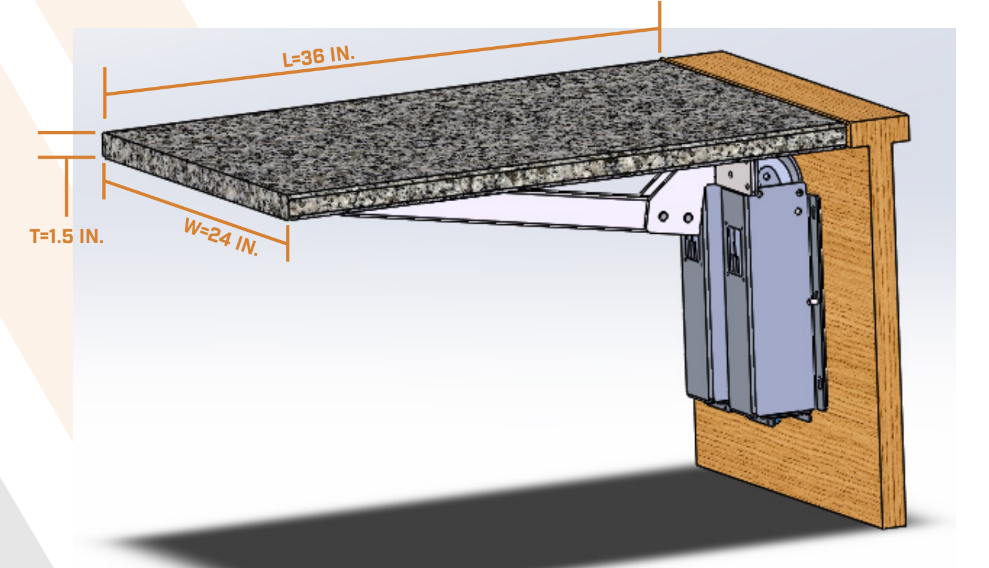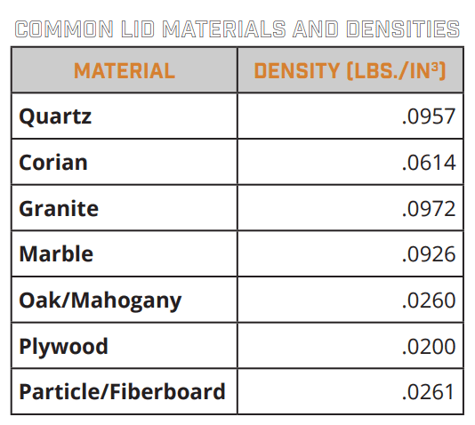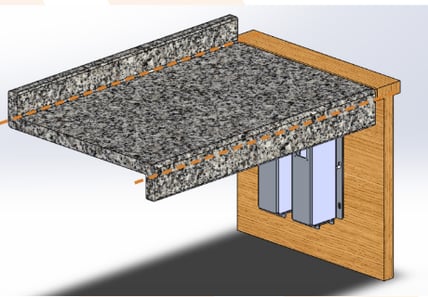
You’ve decided to install a flip-up countertop with a Lift Gate Assistant hinge – congratulations!
Now it’s time to get to the real work of calculating. The formula is simple – to order the right hinge, you’ll need to know your countertop or lid weight and its length, width, and thickness.
Let’s not guesstimate how much it weighs. That never works out well. Precision is key.
Here we'll look at how to determine the right lift gate assistant hinge for your project based on weight and length, and what you can expect when you order your custom flip-up counter hardware.
Precision is Key
Knowing the weight of an object before installing a hinge is essential to ensuring the hinge is able to support a countertop or lid safely.
Hinges are rated to hold a certain amount of weight, and if the weight exceeds this limit it can cause the hardware to break and cause unsafe conditions. Even worse, right from the start the hinge won’t operate as it’s intended.
Addressing this issue, we’ve developed several Lift Gate Assistant hinge models to fit different needs. We offer single- and dual-hinge models in light, medium, and heavy capacities.
What If You Order The Wrong Hinge and It Doesn’t Work For Your Countertop?
Contact us and we'll discuss return options. Returns can be subject to restocking fees, especially if they are not in new condition – is the finished scratched? Are the threads intact?
Our lead time is typically 2 weeks. Getting your order right out the gate will save you a lot of time, money, and headache.
How To Calculate Lid Weight
Now that you know why it’s important to be as accurate as possible, let’s look at how to calculate your lid or countertop’s weight in the event you don’t have a scale to physically weigh it.
Calculating your lid’s weight is a four-step process:
- Calculate the volume of the lid
- Calculate the volume of the underlayment
- Volume correction
- Calculate the weight
The most common lid construction is to have a top surface made from a countertop material, and a wood underlayment used for fastening the hinge and liftgate mechanism. 
Typically, the wood underlayment will be recessed into the top surface so that it cannot be seen along the edges.
To accurately calculate the weight, you must assess the volume of both the lid and underlayment prior to adding any corrections for volumetric discrepancies.
The following example will guide you through this most common lid construction. However, some notes on other lid designs will be included as well.
What you need to know:
- What materials are the top surface and underlayment?
- What is the density of those materials?
Need more time to read? Take this guide with you!
1. Calculate the Volume of the Lid
Measure the length (L), width (W), and thickness (T) of the lid in order to calculate the volume of the lid (VL).
Make sure all your measurements are in the same units. For this example, we’re using inches.
Calculate the volume of the lid: VL = L × W × T
|
Example: VL = 36 in. × 24 in. × 1.5 in. VL = 1296.0 in.3 |
If your lid design is one solid material without underlayment, skip to step 4.
2. Calculate the Volume of the Underlayment
Measure the length (L), width (W), and thickness (T), to calculate the volume of the underlayment (VU). Again, make sure all your measurements are in the same units.
Calculate the volume of the underlayment: VU = L × W × T
|
Example: VU = 35.5 in. × 23 in. × 1.0 in. VU = 816.5 in.3 |
3. Volume Correction
Back in step one we calculated the volume of the lid as if it were a solid with no recess. Now the recess needs to be accounted for.
The correct volume (VC) for the lid is VL calculated in step one minus VU of the underlayment.
For this to be accurate we are assuming that the underlayment is a close fit to the recess and there are no large voids between the two.
|
Example: VC = VL − VU VC = 1296 in.3 − 816.5 in.3 VC = 479.5 in.3 |
4. Calculate the Weight
The weight of the lid is a calculation using the volume and the density.
Weight (lbs.) = Volume (in.3) × Density (lbs./in.3)
In the following example, we’ll plug in granite as our top surface material to find our “weight top” (WT). And we’ll use plywood as underlayment to calculate the “weight underlayment” (WU).
|
Example: WT = VC × DGRANITE WT = 479.5 in.3 × .0972 lbs./in.3 WT = 46.6 lbs. WU = VC × DPLYWOOD WU = 816.5 in.3 × .0200 lbs./in.3 WU = 16.3 lbs. Total Weight = WT + WU Total Weight = 46.6 lbs. + 16.3 lbs. Total Weight = 62.9 lbs. |
Now that you’ve got your lid’s weight, you can enter it in our Lift Gate Assistant Lid Calculator to find your hinge!
Not Working With a Rectangular Lid?
If your lid design uses simple geometric shapes this same process can be used to calculate the weight.
One tip is to slice the lid into easy-to-measure sections and follow the process for each section.
The orange dashed lines in this image show good places to slice the geometry.
If your lid design is irregularly shaped (like live edge wood or curved), then our Lift Gate Assistant might not work for your lid or countertop.
Irregularly shaped lids sometimes aren’t compatible with our custom hinges, because their center of gravity may be different than what the Lift Gate Assistant is designed to support.
Don’t despair, though – we love a challenge! Ask one of our mechanical motion control expert engineers if we can make your dreams for a flip-up countertop come true:
Placing Your Order
You’ve determined your countertop’s:
- Shape
- Dimensions
- Weight
Now you’re ready to contact Weber Knapp and order your custom flip-up countertop hinge! We’re open 8 a.m. – 5 p.m. EST, Monday through Friday.
Call: 800.828.9254
Email: sales@weberknapp.com
We’ll ask that you pay by credit card and send digital copies of your order information to the email you specify so you have everything you need for your records.
Your Lift Gate Assistant hinge(s) should arrive to you within two weeks of your order with installation instructions.
Your Custom Flip-Up Countertop
Finding the right Lift Gate Assistant hinge for your custom flip-up countertop project is easy when you have the right tools.
Take this guide with you as a reference to help find your lid’s weight. Then use our Lift Gate Assistant Lid Calculator to plug in your lid’s weight and length, and we'll provide a part number that's perfect for you.
You’re going to love the space-saving and safety features of your new custom flip-up countertop.
Need an Engineer’s Input?
No problem! We’re happy to check your math (or do it for you) and get you the Lift Gate Assistant that fits your needs. Ask a Weber Knapp engineer for help:
.png?width=12000&height=2033&name=WeberKnappLogo_white%20(1).png)




